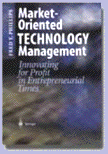Your book is a good text for graduate
students,
and
I plan to use it in my graduate courses.
Dr. Rob Law, The Hong Kong Polytechnic University, CHINA
I have enjoyed reading your book including re-visiting
some of
the
material and references that I tend to use and also for your sage
examples
and lessons from the trenches and being an astute observer.
Dr. David Corkindale, University of South Australia, AUSTRALIA
We have Professor Fred Phillips' insightful and often
provocative
text to give us the theory as well as the conceptual framework needed
for
an understanding of the business side of technology.
Prof. Harvey Utech, Oregon Health & Science University, USA
Your extensive research and literature [review were]
invaluable
for
me.
Ati Serpoushan, student, Jönköping International
Business
School, SWEDEN
I chose your textbook, Market-Oriented Technology
Management,
as the textbook for my course in “Managing Technology & Innovation.”
Bruce Turner, Ph.D., Lecturer of Managing Technology &
Innovation,University
of Applied Sciences, Berne, SWITZERLAND
I am glad that I could get
hold
of a copy of your book. It looks very helpful.
Prof M W Pretorius, University of Pretoria, SOUTH AFRICA
